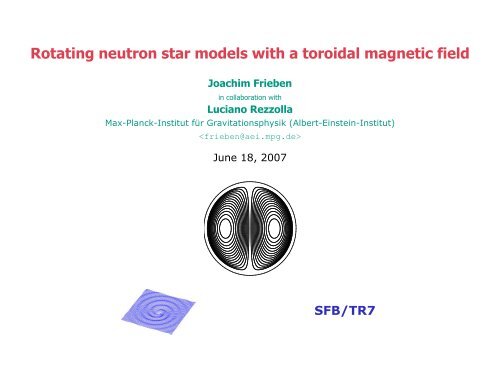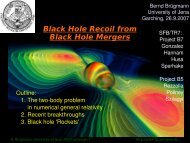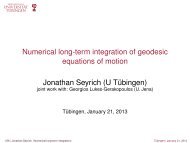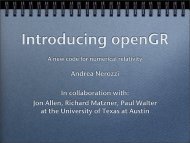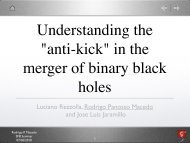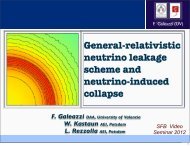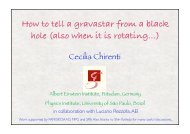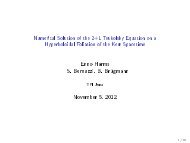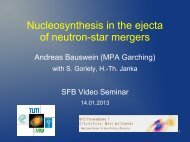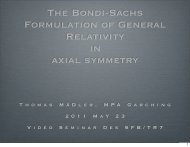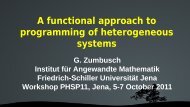Rotating neutron star models with a toroidal magnetic field - SFB/TR7
Rotating neutron star models with a toroidal magnetic field - SFB/TR7
Rotating neutron star models with a toroidal magnetic field - SFB/TR7
You also want an ePaper? Increase the reach of your titles
YUMPU automatically turns print PDFs into web optimized ePapers that Google loves.
<strong>Rotating</strong> <strong>neutron</strong> <strong>star</strong> <strong>models</strong> <strong>with</strong> a <strong>toroidal</strong> <strong>magnetic</strong> <strong>field</strong><br />
Joachim Frieben<br />
in collaboration <strong>with</strong><br />
Luciano Rezzolla<br />
Max-Planck-Institut für Gravitationsphysik (Albert-Einstein-Institut)<br />
<br />
June 18, 2007<br />
<strong>SFB</strong>/<strong>TR7</strong>
Outline<br />
1<br />
(1) Motivation<br />
(2) Theoretical formulation<br />
(3) Numerical implementation<br />
(4) Results for an n=1 polytropic equation of state<br />
(5) Results for realistic equations of state<br />
(6) Conclusion<br />
Joachim Frieben Golm, June 18, 2007
Motivation<br />
2<br />
Quest for astrophysical sources of gravitational radiation triggered by large scale Laser<br />
interferometric gravitational wave detectors, such as LIGO, Virgo, or GEO600.<br />
Potential candidates: rapidly rotating, strongly magnetized <strong>neutron</strong> <strong>star</strong>s (magnetars<br />
beyond B ≃ 10 15 G) <strong>with</strong> a dominant <strong>toroidal</strong> <strong>field</strong> component inducing a prolate deformation<br />
of the <strong>star</strong>.<br />
Jones (1975): viscous processes drive the axis of symmetry orthogonal to J<br />
=⇒ bar shaped source of gravitational waves!<br />
Open questions:<br />
• Prolate deformation (Q < 0) possible? Dependency<br />
on rotation frequency f and <strong>toroidal</strong> <strong>magnetic</strong> <strong>field</strong><br />
strength B? Magnitude?<br />
• Influence of general relativistic effects?<br />
• Influence of the equation of state?<br />
If so, for which parame-<br />
• Configurations unstable?<br />
ters?<br />
Figure from Braithwaite & Spruit (2004)<br />
Joachim Frieben Golm, June 18, 2007
Theoretical formulation<br />
3<br />
Assumptions: (1) space-time stationary, axisymmetric, and asymptotically flat,<br />
(2) matter obeys circularity condition (no meridional component of momentum density<br />
vector (massless charge carriers)), hereafter restriction to a perfect fluid.<br />
Then: stress-energy tensor reads<br />
T = (e+p)u ⊗ u + pg + T EM , (1)<br />
<strong>with</strong> fluid proper energy density e, fluid pressure p, fluid four-velocity u and space-time<br />
metric tensor g. Standard coordinates compliant <strong>with</strong> assumptions are quasi-isotropic<br />
(polar) coordinates, conformally flat in (r,θ)-coordinate planes.<br />
g µν d x µ d x ν = −N 2 dt 2 + B 2 r 2 sin 2 θ (dφ − N φ dt) 2 + A 2 (dr 2 + r 2 dθ 2 ) . (2)<br />
Coordinates are global ones and cover all space. Compatibility of a purely <strong>toroidal</strong><br />
<strong>magnetic</strong> <strong>field</strong> <strong>with</strong> quasi-isotropic coordinates established by Oron (2002).<br />
Electro<strong>magnetic</strong> contribution to stress energy tensor:<br />
T EM<br />
αβ = (1/4π)(F ακF κ β − (1/4)F κλ F κλ g αβ ) . (3)<br />
Joachim Frieben Golm, June 18, 2007
Theoretical formulation<br />
4<br />
Electro<strong>magnetic</strong> contribution to (3+1) matter variables E, J, and S:<br />
E EM = 1 (<br />
8π<br />
B φ<br />
Br sinθ<br />
Equation of stationary motion:<br />
) 2<br />
, J EM<br />
i = 0 , S EMr r = S EMθ θ = −S EMφ φ = E EM . (4)<br />
∂<br />
1<br />
∂xi(H + ν − lnΓ) +<br />
e + p<br />
1<br />
8πB 2 N 2 r 2 sin 2 θ<br />
∂(NB φ ) 2<br />
∂x i = 0 . (5)<br />
Eq. (5) only satisfied if Lorentz force term derived from a scalar function M(r,θ), hence<br />
1 1 ∂(NB φ ) 2<br />
e + p8πB 2 N 2 r 2 sin 2 θ ∂x i<br />
= ∂M<br />
∂x i . (6)<br />
Existence of a first integral of motion established for the particular (simple) choice of<br />
NB φ = µ(e+p) B 2 N 2 r 2 sin 2 θ , M = µ2<br />
4π (e+p) B2 N 2 r 2 sin 2 θ . (7)<br />
Joachim Frieben Golm, June 18, 2007
Numerical method<br />
5<br />
Problem: (1) sources of elliptic <strong>field</strong> equations fill all space,<br />
(2) exact boundary condition (of asymptotic flatness) only known at spatial infinity,<br />
(3) sources of elliptic equations involve quadratic terms of derivatives of metric<br />
potentials themselves.<br />
Approach: iterative procedure (relaxation) based on surface-adapted multi-domain<br />
spectral method derived from LORENE C++ class library for numerical relativity.<br />
Expand scalar and vector functions according to<br />
f (r,θ) =<br />
L∑<br />
a l (r)coslθ , U ˜φ (r,θ) =<br />
l=0<br />
L∑<br />
l=1<br />
a ˜φ<br />
l<br />
(r)sinlθ . (8)<br />
Angular expansion by Fourier series, radial expansion by Chebyshev polynomials.<br />
Use three domains: (1) spheroidal kernel containing all the matter,<br />
(2) intermediate domain covering the neighbourhood of the <strong>star</strong>,<br />
(3) outer (vacuum) domain stretching to spatial infinity, mapped onto finite grid.<br />
Code validation: (1) Full agreement <strong>with</strong> Newtonian results e.g. of Sinha (1968),<br />
(2) for each model, error estimate provided by GRV2/GRV3 (10 −6 to 10 −10 ).<br />
Joachim Frieben Golm, June 18, 2007
Results for an n=1 polytropic equation of state<br />
6<br />
Isocontours of the <strong>magnetic</strong> <strong>field</strong><br />
strength for a non-rotating M = 1.4 M ⊙<br />
model <strong>with</strong> a circumferential radius of<br />
R = 12km in the non-<strong>magnetic</strong> case. The<br />
peak value is B p = 5.34 × 10 17 G which is<br />
the maximum possible. Upper physical<br />
limit for B p due to buoyancy estimated<br />
by Wheeler (2000):<br />
( )<br />
B f ≃ 2 × f 1/2 ρ 1/2<br />
×<br />
10 13 gcm −3 × 10 18 G ,<br />
where f ≃ 0.01. Resulting maximum<br />
<strong>field</strong> strengths of B = 10 16 − 10 17 G.<br />
Joachim Frieben Golm, June 18, 2007
Results for an n=1 polytropic equation of state<br />
7<br />
Isocontours of the <strong>magnetic</strong> potential<br />
for the same model as on the previous<br />
slide.<br />
Joachim Frieben Golm, June 18, 2007
Results for an n=1 polytropic equation of state<br />
8<br />
Isocontours of the log-enthalpy for the<br />
same model as on the previous slide.<br />
Joachim Frieben Golm, June 18, 2007
Results for an n=1 polytropic equation of state<br />
9<br />
11.25<br />
11<br />
polar coordinate radius<br />
equatorial coordinate radius<br />
R [km]<br />
10.75<br />
10.5<br />
10.25<br />
10<br />
Equatorial and polar radius<br />
as a function of the peak<br />
<strong>magnetic</strong> <strong>field</strong> strength for<br />
a non-rotating M = 1.4 M ⊙<br />
model <strong>with</strong> a circumferential<br />
radius of R = 12km in<br />
the non-magnetized case.<br />
9.75<br />
0 0.1 0.2 0.3 0.4 0.5 0.6 0.7 0.8 0.9 1<br />
(B p /5.34 × 10 17 G) 2<br />
Joachim Frieben Golm, June 18, 2007
Results for an n=1 polytropic equation of state<br />
10<br />
1<br />
0.9<br />
0.8<br />
(Bp/5.34 × 10 17 G) 2<br />
0.7<br />
0.6<br />
0.5<br />
0.4<br />
0.3<br />
1<br />
0.95<br />
0.85<br />
0.75 0.7<br />
Isocontours of ratio r p /r e of polar<br />
to equatorial radius as a function<br />
of peak <strong>magnetic</strong> <strong>field</strong> strength<br />
and rotation frequency for an M =<br />
1.4 M ⊙ model <strong>with</strong> a circumferential<br />
radius of R = 12km in the nonmagnetized<br />
case.<br />
0.2<br />
0.65<br />
0.1<br />
0.9<br />
0.8<br />
0.6<br />
0<br />
0 0.1 0.2 0.3 0.4 0.5 0.6 0.7 0.8 0.9 1<br />
( f /828 Hz) 2<br />
Joachim Frieben Golm, June 18, 2007
Results for an n=1 polytropic equation of state<br />
11<br />
1<br />
0.9<br />
-0.06<br />
-0.05<br />
0.8<br />
-0.04<br />
-0.03<br />
(Bp/5.34 × 10 17 G) 2<br />
0.7<br />
0.6<br />
0.5<br />
0.4<br />
0.3<br />
0.2<br />
-0.02<br />
-0.01<br />
0.01<br />
0<br />
0.02<br />
0.03<br />
0.04<br />
0.05<br />
0.06<br />
0.07<br />
0.08<br />
0.090.1<br />
Isocontours of distortion ɛ = −3/2×<br />
Q zz /I as a function of peak <strong>magnetic</strong><br />
<strong>field</strong> strength and rotation frequency<br />
for an M = 1.4 M ⊙ model<br />
<strong>with</strong> a circumferential radius of<br />
R = 12km in the non-magnetized<br />
case.<br />
0.1<br />
0.12 0.13<br />
0<br />
0.11<br />
0.14<br />
0 0.1 0.2 0.3 0.4 0.5 0.6 0.7 0.8 0.9 1<br />
( f /828 Hz) 2<br />
Joachim Frieben Golm, June 18, 2007
12<br />
Results for an n=1 polytropic equation of state<br />
10 −2<br />
10 −3<br />
10 −4<br />
10 −5<br />
Bonazzola & Gourgoulhon (1996)<br />
Cutler (2002)<br />
Magnetic distortion ɛ B as a<br />
function of circumferential<br />
radius R at fixed average<br />
<strong>magnetic</strong> <strong>field</strong> strength for<br />
a non-rotating M = 1.4 M ⊙<br />
model computed according<br />
to Bonazzola & Gourgoulhon<br />
(1996) and Cutler<br />
(2002) respectively.<br />
−ǫ B<br />
10 1 10 2<br />
10 −6<br />
R [km]<br />
Joachim Frieben Golm, June 18, 2007
Results for realistic equations of state<br />
13<br />
Isocontours of the <strong>magnetic</strong> <strong>field</strong><br />
strength for a non-rotating M = 1.4 M ⊙<br />
model based on the SLy4 EOS. The peak<br />
value is B p = 2.47 × 10 17 G which is the<br />
maximum possible.<br />
Joachim Frieben Golm, June 18, 2007
Results for realistic equations of state<br />
14<br />
Isocontours of the <strong>magnetic</strong> potential<br />
for the same model as on the previous<br />
slide.<br />
Joachim Frieben Golm, June 18, 2007
Results for realistic equations of state<br />
15<br />
Isocontours of the log-enthalpy for the<br />
same model as on the previous slide.<br />
Joachim Frieben Golm, June 18, 2007
Results for realistic equations of state<br />
16<br />
3×10 −6<br />
2×10 −6<br />
• BalbN1H1<br />
• GlendNH3<br />
• Pol2C10<br />
2×10 −7 3×10 −7<br />
c B Pol2F10 •<br />
1×10 −6<br />
• SLy4<br />
Pol2 •<br />
AkmalPR<br />
BBB2 •<br />
• FPS<br />
• BPAL12<br />
0<br />
0 1×10 −7 4×10 −7<br />
Distortion coefficients for realistic<br />
equations of state for<br />
<strong>models</strong> <strong>with</strong> M = 1.4 M ⊙ in the<br />
non-rotating and non-magnetized<br />
case. The <strong>star</strong> radius<br />
increases as a function of the<br />
EOS from BPAL12 bottom left<br />
to GlendNH3 top right. Pol2<br />
labels a relativistic model based<br />
upon a γ = 2 polytropic<br />
EOS <strong>with</strong> a radius of R =<br />
12km. Pol2F10 denotes the<br />
coefficients of a model at the<br />
Newtonian limit <strong>with</strong> a radius<br />
of R = 10km, Pol2C10 the<br />
corresponding values given<br />
by Cutler (2002).<br />
c Ω<br />
( ) 2 ( ) 2<br />
¯B f<br />
ɛ = ɛ B + ɛ Ω = −c B + c<br />
10 15 Ω , ¯B = 〈B 2 〉 1/2 . (9)<br />
G Hz<br />
Joachim Frieben Golm, June 18, 2007
Conclusion<br />
17<br />
• First fully relativistic <strong>models</strong> of rotating <strong>star</strong>s <strong>with</strong> a <strong>toroidal</strong> <strong>magnetic</strong> <strong>field</strong>:<br />
⋆ Only slight prolate deformation of the apparent shape.<br />
⋆ Noticeable impact on matter distribution inside the <strong>star</strong>.<br />
⋆ Magnetic <strong>field</strong> leads to an overall growth of the <strong>star</strong>.<br />
⋆ For astrophysically relevant range of rotation frequency and <strong>magnetic</strong> <strong>field</strong> strength<br />
perturbative treatment justified.<br />
⋆ General relativistic effects attenuate the <strong>magnetic</strong> distortion.<br />
⋆ Influence of realistic EOS dominated by impact on actual radius.<br />
⋆ Magnetic and rotational deformation parameters given by Cutler (2002) significantly<br />
too large.<br />
• Further directions to explore:<br />
⋆ Global study of <strong>neutron</strong> <strong>star</strong> <strong>models</strong> <strong>with</strong> a <strong>toroidal</strong> <strong>magnetic</strong> <strong>field</strong>.<br />
⋆ Implement differential rotation.<br />
⋆ Implement mixed <strong>magnetic</strong> <strong>field</strong>s (poloidal and <strong>toroidal</strong>).<br />
⋆ Investigate instability of magnetized <strong>models</strong>.<br />
Joachim Frieben Golm, June 18, 2007
References<br />
18<br />
P. B. Jones, Astrophys. Space Sci., 33, 215 (1975)<br />
A. Oron, Phys. Rev. D 66, 023006 (2002)<br />
http://www.lorene.obspm.fr<br />
N. K. Sinha, Aust. J. Phys., 21, 283 (1968)<br />
J. C. Wheeler, I. Yi, P. Höflich, and L. Wang, Astrophys. J., 537, 810 (2000)<br />
S. Bonazzola and E. Gourgoulhon, Astron. Astrophys. 312, 675 (1996)<br />
C. Cutler, Phys. Rev. D 66, 084025 (2002)<br />
Golm, June 18, 2007


